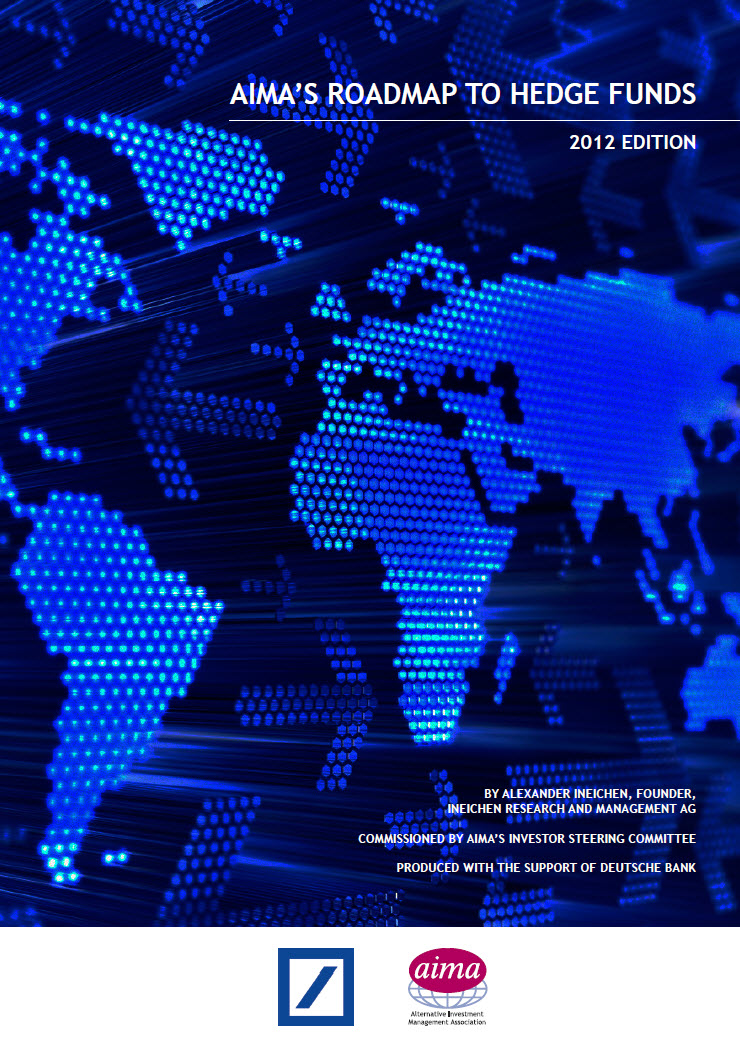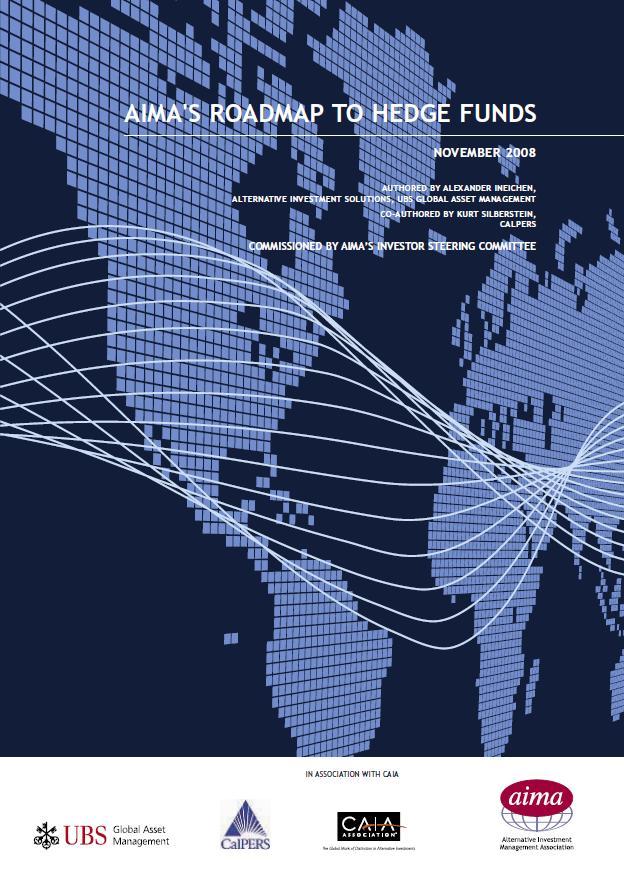|
AIMA AND DEUTSCHE BANK PUBLISH NEW ‘ROADMAP TO HEDGE FUNDS’ FOR INSTITUTIONAL INVESTORS
The new Roadmap to Hedge Funds can be downloaded here.
London – 20 November 2012: The Alternative Investment Management Association (AIMA), the global hedge fund association, and Deutsche Bank today announced the launch of a new edition of the educational guide for institutional investors in hedge funds - the Roadmap to Hedge Funds.
The new Roadmap to Hedge Funds, published jointly by AIMA and Deutsche Bank, outlines how the volatile external environment has driven an ever greater need for active risk management. In re-affirming the case for investing in hedge funds, the Roadmap highlights how the industry responded swiftly to the losses of 2008. The average hedge fund recovered from its 2008 losses by October 2010, in contrast with global equities which are not expected to recover their financial crisis losses until at least 2015. Other highlights from the Roadmap to Hedge Funds include:
The original edition of the Roadmap to Hedge Funds was published in 2008, and was the world’s first collaborative educational guide for institutional investors in hedge funds. It de-mystified the industry by tackling misconceptions. It offered guidance on creating and managing a hedge fund portfolio and gave an in-depth view of hedge fund strategies, valuation, leverage, liquidity and risk management. The updated Roadmap to Hedge Funds was also authored by Alexander Ineichen, founder of Ineichen Research and Management (IR&M). Andrew Baker, AIMA’s CEO, said: “AIMA has always worked closely with the investor community to promote greater understanding of hedge funds. We are not pretending that the last four years have been easy for the industry, but if anything in difficult times like this the case for assets to be actively managed by specialised managers with a variety of tools at their disposal is even more compelling.” Anita Nemes, Global Head of Capital Introduction at Deutsche Bank, said: “Not only has the hedge fund industry undergone a rapid transformation over the past four years, but attitudes to hedge fund investing have changed just as much. An increasingly institutional investor base brings with it a new set of client demands, including greater transparency and improved reporting and risk management. The Roadmap to Hedge Funds provides the analysis and voice behind these fundamental changes to the industry.” Alexander Ineichen, founder of IR&M, said: “The main differentiation between hedge funds and traditional asset management is risk management. Over the past four years an active risk management stance has resulted in a reduction of risk. The reason for more conservative risk taking is mainly a rise in uncertainty related to artificially enhanced asset prices and other forms of intervention. The modest returns of hedge funds over the past four years are a direct result of taking less risk. In essence, hedge funds have done what they are designed to do, which is take risk off the table when uncertainty rises.” |
|
|
2008 edition: AIMA’s Roadmap to Hedge Funds - the world’s first collaborative educational guide for institutional hedge fund investors. Aimed at intermediate level investors, the Roadmap aims to ‘de-mystify’ the hedge fund industry and tackle the misconceptions on issues such as short-selling, fees, transparency and the notion that hedge funds are risky, speculative and increase systemic risk. The Roadmap also offers guidance on creating and managing a hedge fund portfolio and gives an in-depth view of hedge fund strategies in investment, valuation, leverage, liquidity and risk management. The roadmap can be downloaded here.
A hedge fund constitutes an investment program whereby the managers or partners seek absolute returns by exploiting investment opportunities while protecting principal from potential financial loss. The first hedge fund was indeed a hedged fund. The hedge funds/alternative investment moniker is a description of what an investment fund is not rather than what it is. The universe of alternative investments is just that – the universe. The favourable relative performance of hedge funds is worth highlighting as it is often brushed aside and is in stark contrast to the heavy artillery the industry regularly finds itself under: A hypothetical investment in the S&P 500 Total Return Index of a $100 at the beginning of this decade stood at $92.1 by September 2008. A hypothetical investment of $100 in the HFRI Fund Weighted Hedge Fund Index stood at $174.9. We think this to be a big difference. The pursuit of absolute returns is much older than the idea of beating a benchmark. Constructing portfolios with low compound annual returns, high volatility and high probability of large drawdowns is easy. Constructing portfolios with high compound annual returns, low volatility and low probability of large drawdowns is not. Losses kill the rate at which capital compounds. Defining risk as the attempt to avoid losses is materially different than trying to avoid underperforming a benchmark. The paradigm of relative returns might soon be perceived as a short blip or ideological error in the evolution of investment management. Hedge funds are active investment managers. Active investment management is dependent on the willingness to embrace change and, more importantly, to capitalise on it. Adaptability is the key to longevity. In active risk management, it is important to apply a skill that carries a reward in the market place within an opportunity set where the risk/reward trade-off is skewed in favour of the risk-taker. The reward from skill is not constant. Profitable ideas, approaches and techniques get copied and markets become immune to the applicability of the skill — that is, markets become more efficient. Skill needs to be dynamic and adaptive — that is, it needs to evolve to remain of value. Hedge funds do not hedge all risks. If all risks were hedged, the returns would be hedged too. Hedge funds take risk where they expect to get paid for bearing risk while hedging risks that carry no premium. The investment process of a hedge fund investor is dynamic and can be classified into two selection processes (manager selection and portfolio construction) and two monitoring processes (manager review and risk management). Initial and ongoing assessment and due diligence of the hedge fund managers is probably the single most important aspect of the investment process for all hedge fund investors. Portfolio construction and managing the risk of the hedge fund portfolio are also mission-critical in the hugely heterogeneous and dynamic hedge fund industry. Manager evaluation and monitoring has become more difficult despite increases in transparency and information flow, and it has become more labour-intensive. Investors with vast resources for research are likely to continue to have an edge over investors with little or no research capabilities. Large parts of mainstream academia repeatedly highlights that hedge fund data is poor, markets are efficient and hedge funds engage in short put strategies, essentially defrauding their investors. What academia never seems to mention is that there are few investors who have invested in diversified hedge fund portfolios for ten years or longer yet are unhappy with their investments. Most investors who moved into alternative investments have done so for conservative, financial purposes. These investors moved away from relying fully on equities and bonds increasing in value to achieve sustainable and smooth wealth accumulation and preservation. One of the central drivers of alternative investments in this decade is the realisation by an increasing number of investors that the source of returns from various alternative asset classes and hedge fund strategies is not identical. While there are varying complicating matters such as valuation and liquidity issues as well as non-linear payouts, the bottom line is that the source of return from various “alternatives” differs fundamentally. |
|


